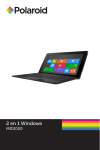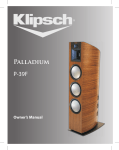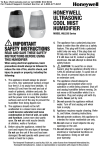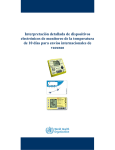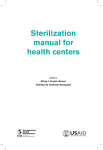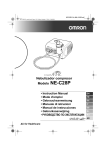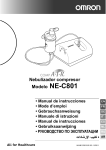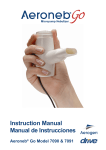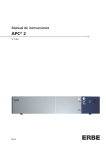Download Nebulizer Manual_0815_1
Transcript
Voyager™ Pro Nebulizer CAUTION: 18018 Federal (US) Law restricts this device to sale by or on the order of a physician. CONTENTS Getting acquainted Safety information and warnings Important information on the device 02 02 07 .Accessories .Protecting against leaks .Automatic switch-off Know Your Voyager™ Pro Nebulizer Initial use 08 09 .Before using the device for the first time .Assembly .Battery Replacement .Operating the device with the switching power supply Operation 12 .Preparing the nebulizer .Filling the nebulizer .Closing the nebulizer .Fitting accessories .Inhaling correctly Cleaning and disinfection 15 .Warning .Cleaning .Disinfection .Disassembly .Drying .Material resistance .Storage How to replace the mesh nebulizer Troubleshooting Specifications Manufacture Date Warranty Information 20 21 23 24 25 01 Getting acquainted Area of application The Voyager™ Pro nebulizer is a vibrating mesh nebulizer for treating the upper and lower respiratory tract. The nebulization and inhalation of medication prescribed or recommended by a doctor can prevent against diseases of the respiratory tract, treat the side effects of these disorders and accelerate healing. For more information on possible applications, consult your doctor or pharmacist. The device is suitable for inhalation at home or on the move. Medicines should only be inhaled when instructed by a doctor. Inhalation should be performed in a calm and relaxed atmosphere. Inhale slowly and deeply to enable the medicine to reach the small bronchi deep into the lungs. Exhale normally. Safety information and warnings Warning .Before use, ensure that there is no visible damage to the device or accessories. When in doubt, do not use the device and contact your equipment provider. .Using the device is not a substitute for consultation with or treatment from a physician. Whenever you have any pain or illness, always contact your physician first. .If you have health concerns of any kind, contact your general practitioner. .When using the nebulizer, always follow the basic hygiene procedures. .Always follow your doctor’s instructions regarding the type of medicine to be used and the dose, frequency, and duration of inhalation. .Only use medicines that have been prescribed or recommended by your doctor or pharmacist. 02 .If the device does not function correctly or if you begin to feel unwell or feel pain, stop using the device immediately. .During use, hold the device away from the eyes, as some nebulized medicines may cause damage to the eyes. .Do not operate the device in the presence of flammable gases. .Do not use the device near electromagnetic transmitters. .This device is not intended to be used by children or persons with restricted physical, sensory (e.g. insensitivity to pain) or mental abilities or persons lacking in the required experience or knowledge for safe operation of the device, unless supervised or instructed by a person responsible for their safety. .Keep children away from packaging materials (risk of suffocation). .Do not use attachments that are not recommended by the manufacturer. .Do not dip or submerge the device into water and do not use it in wet rooms. Do not allow any liquid to penetrate the device. .Protect the device from strong impacts. .Do not use the device if it has fallen or been dropped on the floor, been exposed to extreme humidity or is otherwise damaged. In case of doubt, contact our customer service department or your local dealer. .The Voyager ™ Pro Nebulizer must only be operated along with the appropriate Drive Medical accessories. The use of other accessories can impair therapeutic efficiency and may damage the device. .Remove the batteries from the device if you will not be using it for an extended period. Leaking batteries may damage the device. .Always keep mesh nebulizer in the device. A drop or fall in 4 in (10 cm) height may cause it broken or damage. .Always dry the device, including mesh nebulizer and medicine container. Oxides may block the mesh hole and impair the nebulizer efficiency. 03 Important .Power loss, sudden faults or other unfavorable conditions may render the device unusable. You are therefore recommended to keep a spare device or replacement medicine (as agreed with the doctor). .The device must be stored away from sources of heat. .Do not use the device in a room in which a spray has previously been used. If this is the case, ventilate the room before commencing treatment. .For reasons of hygiene , each user should use their own set of accessories (mesh nebulizer, mask and mouthpiece). .Store the device in a location protected against environmental influences. The device must be stored in the specified ambient conditions. .Do not use any medicines in powder (even if dissolved). .Do not shake the nebulizer, as this may cause liquid to leak, thereby damaging the device. 04 General notes Important .Use the device only: .On humans .For its intended purpose (aerosol inhalation) and in the manner described in these instructions for use. .Any improper use can be dangerous! .In acute emergencies, first aid takes priority. .In addition to medicines, use only a saline solution. .This device is not intended for commercial use, but only for individual use. Before using the device for the first time Important .Before you use the device for the first time, remove all packaging materials. .Protect the device from dust, dirt and moisture. .Do not use the device in very dusty environments. .Before use, ensure the device and accessories are at room temperature. .Switch the device off immediately if it is defective or malfunctioning. .The manufacturer shall not be held liable for damage or injuries caused by improper or incorrect use. 05 Notes on handling batteries .Keep batteries out of the reach of children. Children can put batteries in their mouths and swallow them. This can cause severe harm to their health. In this case, consult a physician immediately. .Normal batteries must not be recharged, heated or thrown into open flame (risk of explosion). .Leaking batteries may damage the device. If you do not intend to use the device for prolonged periods, remove the batteries from the battery compartment. Caution Leaking or damaged batteries can cause burns upon contact with the skin. When removing such batteries, wear suitable protective gloves. Repairs Note .Never open or attempt to repair the device by yourself, as otherwise proper function is no longer guaranteed. Failure to observe this regulation shall void the warranty. .If you need to have the device repaired, contact your equipment provider. 06 Important information on the device Accessories The safe functioning of the device can only be guaranteed if the accessories recommended by the manufacturer are used. Caution Protecting against leaks When filling the medicine container with medicine, ensure that you do not exceed the maximum mark (8 ml). The recommended filling amount is between 2 and 8 ml. During use, you can tilt the device up to a maximum angle of 45˚ in any direction, without impairing its nebulizing function or success of the treatment. However, spraying only takes place if the substance to be sprayed is in contact with the mesh. If it is not, spraying stops automatically. If this happens, please try to hold the device as upright as possible. Automatic switch-off The device has an automatic switch-off function. To prevent damage to the mesh, the device switches off automatically when the liquid has been almost used up. Do not use the device if the medicine container is empty. The device switches off automatically if the substance to be sprayed is no longer in contact with the mesh. 07 Know Your Voyager™ Pro Nebulizer Overview 1. 1. Cover 2. Medicine container 3. Mesh Nebulizer 3. 4. On/Off button 2. Blue : device ready Yellow : change batteries 5. Battery compartment 4. 6. Mini USB port 6. 5. 7. Overview of accessories 8. 7. Adult mask 8. Child mask 9. Mouthpiece 10. Connecting piece 10. 9. 11. AAA Battery x 4 11. 12. AC Adapter 13. USB cable 14. Soft Pouch 08 12. 13. 14. Initial use Before using the device for the first time Note: .Before first use, the nebulizer and the accessories should be cleaned and disinfected. For more information, see page 15. Important! Ensure that you do not touch the mesh, as this may destroy it. Assembly Remove the device from the packaging. .If not already fitted, fit the mesh nebulizer onto the neck of the container, and lock the neck in place by turning it counterclockwise until the gold-colored contact electrodes are facing down wards. First Second .Place the container with fitted mesh firmly onto the housing or base of the device, until you hear it click into place on the left and right. 09 Battery Replacement 1. Turn the device upside down, and follow the sign on the bottom cover to “Open” the bottom cover. 2. Take off the bottom cover, and take off the old batteries, and replace four new AAA batteries. Lock 4. Follow the sign on the bottom cover to “ Lock” the bottom cover. Lock Open 3. Align the three lines with the groove to cover over. Open Note: .When changing batteries, ensure that the medicine container is completely empty, otherwise there is a risk of leaks. .Spraying becomes much less effective when batteries are weak; therefore, when the yellow LED lights up, replace all four batteries. 10 Operating the device with the AC Adapter Connect the USB cable and AC Adapter, insert the USB cable into mini USB port. Plug the AC Adapter into an appropriate outlet. .If not already fitted, fit the mesh nebulizer onto the neck of the container, and lock the neck in place by turning it clockwise until the gold-colored contact electrodes are facing downwards. Note: .Lay the cable in such a way that no one can trip over it. .To disconnect the nebulizer from the USB cable after use, first switch off the device and then remove the USB cable and AC Adapter from the mini USB port. .The AC Adapter can not be used for charging batteries. 11 Operation Preparing the nebulizer .For reasons of hygiene, it is imperative that the nebulizer and accompanying accessories are cleaned and disinfected after every use. If the therapy requires that different medicines be inhaled one after another, ensure that the nebulizer is rinsed and cleaned after every application. For details, see Cleaning and Disinfection on page 15. .Remove the cover from the device. Filling the nebulizer .Open the medicine container by lifting the clip, and fill the medicine container with an isotonic saline solution or medicine. Do not overfill! The maximum recommended fill level is 8 ml. .Use medication only on the advice of a physician, and check the appropriate inhalation duration and quantity for your needs. .If the recommended dose of the medicine is less than 2 ml, top off this quantity to at least 4 ml using only isotonic saline solution. Viscous medicines may also require dilution. Always follow the instructions of your doctor. Closing the nebulizer .Close the lid of the medicine container, and then refit the cover. 12 Fitting accessories .When the required accessories (mouthpiece, adult mask or child mask) have been attached to the device, join the device firmly to the assembled medicine container. .The adult mask and child mask must be fitted using the connecting piece. .Now place the device to your mouth and close your lips firmly around the mouthpiece.When using either of the masks, place it over the nose and mouth. .Start the device by pressing the on/off button. .The spray mist coming from the device and the illuminated blue LEDs show that the device is working perfectly. Inhaling correctly .Breathing technique The right breathing technique is important to ensure that the particles are distributed as widely as possible into the air ways, and that they can enter the air ways and lungs.You must inhale slowly and deeply, hold your breath briefly (5 to 10 seconds) and then exhale quickly. .You should only use a nebulizer to treat respiratory disorders if advised to do so by your doctor. Your doctor will recommend the medicine, and application for inhalation therapy. .Certain medicines are only available on prescription. Note: You should hold the device as upright as possible. Tilting it very slightly will not, however, affect its function, since the container is leakproof. To ensure that the device functions fully, make sure that you do not tilt it more than 45˚ in any direction and that the medicine is in contact with the mesh while in use. 13 Important Essential oils, cough medicines, solutions designed for gargling, and drops for application to the skin or for use in steam baths are unsuitable for inhalation using a nebulizer. These substances are often highly viscous and can impair the correct function of the device and hence affect the effectiveness of its application in the long term. In the case of oversensitivity of the bronchial system, medicines containing essential oils can sometimes cause acute bronchiospasm (a sudden, cramp-like tightening of the bronchi accompanied by breathlessness). Always ask your doctor or pharmacist for advice. Only use medications prescribed by your doctor, and in the manner directed by your healthcare professional. .After treatment, switch off the device using the on/off button and the LED blue light will go out. .Once the inhalant has been fully sprayed out, the device switches off automatically. For technical reasons, a small amount may still remain in the medicine container. Do not use it. .If applicable, disconnect the USB cable and AC Adapter from the USB cable. 14 Cleaning and disinfection Warning Observe the following hygiene instructions in order to avoid any health risks. .The nebulizer and accessories are intended for multiple use. Please note that cleaning requirements differ according to the different application areas: Important! Ensure that you do not touch the mesh, as this may destroy it. Note: .Do not clean the mesh or accessories with brushes or similar, as this may cause irreparable damage, which means that the intended result of the treatment is no longer guaranteed. .For additional requirements regarding the necessary hygienic preparations (hand washing, handling of medicines or inhalation solutions) in high-risk groups (e.g. cystic fibrosis patients), contact your doctor. Cleaning The mesh nebulizer and the accessories used, e.g. mouthpiece, mask, medication container, connecting piece, etc. must be cleaned with running water and thoroughly dry them after each use. Once all components are fully dry, gather them together and place them in a dry, sealed container. .Remove the mouthpiece and any accessories from the nebulizer. .Add 4 ml of clean water to the medicine container and switch on the device to remove any medicine residue from the mesh first. (Please spray the entire liquid). .Remove the batteries. .Remove the detachable parts from the device, e.g. mesh nebulizer or medicine container and cover. .The nebulizer is later reassembled in the reverse order. 15 Important .Never hold the complete device or nebulizer unit to clean under running water. When cleaning, ensure that all residues are removed and dry all parts carefully. Never use any substances that may be poisonous when in contact with the skin or mucous membranes, or when swallowed or inhaled. Failure to fully dry each part, especially the vibrating mesh and golden contacts may begin to affect the clinical efficacy of the Voyager™ Pro. Important .Before you clean the device, always switch it off, unplug it and let it cool off. .Do not use abrasive detergents and never immerse the complete device in water. Important .Ensure that no water penetrates inside the device. .Do not put the device or accessories in a dishwasher. .Do not touch the device with wet hands while it is plugged in; do not allow any water to be sprayed onto the device. The device must be operated only when it is completely dry. 16 Disinfection NOTE: The mesh nebulizer should ONLY be cleaned with water. .First clean the nebulizer container and the accessories as described in the cleaning section. You can then continue with disinfection. .Pour 8 ml ethyl alcohol (75% v/v) into the medicine container. Close the container. Leave the alcohol in the container for at least 10 minutes. .For better disinfection, shake the device gently from time to time. Be sure the lid is properly fixed to avoid spilling the solution. .Afterwards, pour the ethyl alcohol out of the container. .Repeat this process, using water this time. .As an alternative to ethyl alcohol, a solution of water and vinegar may be used. Be sure to rinse with clean water and thoroughly dry. Disassembly .To continue with cleaning its individual components, disassemble the nebulizer. .Remove the medicine container and mesh nebulizer by pressing both brackets inwards and drawing the device out. 17 .Remove the mesh nebulizer from the medicine container by turning it clockwise and drawing it out. First Second .The nebulizer is later reassembled in the reverse order. .Finally, clean all the parts again under running water. Important Ensure that you do not touch the mesh, as this may destroy it. The mesh may be rinsed under running water, when necessary, however must be thoroughly dried; otherwise the mesh may become damaged. .If any traces of medical solutions or impurities remain on the gold-colored contacts on the device and nebulizer, use cotton buds to remove them. .Clean the outside of the mesh and outside of the medicine container with a cotton bud. 18 Drying .Place the individual components on a dry, clean and absorbent surface and allow to dry completely (for at least 2 hours). Note: Ensure that all parts are thoroughly dried after cleaning, otherwise there is an increased risk of bacterial growth. Once all components are fully dried, reassemble the nebulizer and place the components in a dry, sealed container. Material Resistance .When choosing a cleaning or disinfecting agent, note the following: Only use mild cleaning or disinfectant agents in the quantities recommended by the manufacturer. .As with all plastic components, frequent use and cleaning of the accessories can lead to a certain amount of wear. Over time, this can alter the aerosol properties and may eventually affect the efficiency of therapy. We therefore recommend that you replace the nebulizer cup and accessories at least once a year. Storage .Do not store the nebulizer in a damp atmosphere (e.g. in the bathroom) or transport it together with damp objects. .Store and transport the nebulizer away from direct sunlight. 19 How to replace the mesh nebulizer The mesh nebulizer is a consumable part. Drive Medical recommends to change the mesh nebulizer after approximately 1 year. Remove the mesh nebulizer and install a new one as described on page 09 (section “Assembly”). For buying new mesh nebulizer, please contact your Drive Medical equipment provider. 20 Troubleshooting Problem/Question The nebulizer produces little or no aerosol Possible Cause/Remedy 1. Too little medicine in the nebulizer. 2. The nebulizer is not held in an upright position. 3. The medicine is unsuitable for spraying (e.g. too thick, highly viscous). The medicine solution should be specified by your doctor. 4. The batteries are dead. Replace the batteries or connect the power supply unit, and try again. 5. There are air bubbles inside the medicine container which are preventing the medicine from coming into contact with the mesh. Please check and remove any air bubbles. 6. Particles on the mesh are inhibiting output. To remove these dirt particles, fill the nebulizer with 2-3 drops of vinegar and 3-6 ml of water then nebulize this solution completely. Please do not inhale this spray and ensure that you clean and disinfect the medicine container afterwards. If the output does not improve, replace the mesh. 7. The mesh is worn out. Replace the mesh. Which medicines are suitable for inhalation? Only your doctor can advise you which medicine to use to treat your condition. Consult your physician. Inhalation with the mask takes longer This is for technical reasons. Less medicine is inhaled per breath through the mask holes than using the mouthpiece. The aerosol is mixed with ambient air through the holes in the mask. 21 Problem/Question What special steps should be taken for babies and children? Possible Cause/Remedy 1. In babies, the mask should cover the mouth and nose to guarantee effective inhalation. 2. In children, the mask should also cover the mouth and nose. It is not suitable to use the nebulizer while sleeping or lying on the bed because the medicine will not reach the lungs sufficiently. Note: Children should only use the device with help and under supervision of an adult. Never leave a child alone with the nebulizer. Does each user need their own accessories? 22 This is absolutely necessary for hygiene reasons. Specifications Model 18018 Particle Size 1.0 – 5.0 µm Technology Vibrating Mesh Medication Container Capacity 8 ml maximum Residual Volume Approx. 0.1ml Electrical Battery 1.5V (AAA batteries ×4) Adapter 100V-240V / 50~60Hz / 0.15A Power Consumption Approx. 1.5W Dimensions (mm) 2.75” (W) x 5.71” (H) x 2.28” (D) Temperature: 37˚F ~ 122˚F (3˚C ~ 50˚C) Operating conditions Storage and transport consitions (no condensation) Relative humidity: Max 70% RH Temperature: 14˚F ~ 176˚F (-10˚C ~ 80˚C) (no condensation) Relative humidity: Max 70% RH <NOTE> .Specifications may be changed without prior notice. .Disposal of this product, the optional accessories and used batteries should be carried out in accordance with the national regulations for the disposal of electronic products. Unlawful disposal may cause environmental pollution. .Using this device with or near other medical/electrical equipment could produce mutual interference. Be sure to read the Instruction Manual for correct installation and use. Also, be sure to read the Instruction Manuals for all other electronic equipment nearby. 23 Manufacture Date According to manufacture date, please see product’s CE label SN number. The SN coding principles are as below. Voyoger™ Pro Nebulizer “Caution: Federal law (US) restricts this device to sale by or on the order of a physician”, “Non-sterile” and “Reusable.” 18018 = Type B Caution Consult Instructions for Use Input 6V ( 4 AAA Batteries) Manufactured For: Drive Medical 99 Seaview Blvd. Port Washington, NY 11050 MADE IN TAIWAN SN Coding principles: The sequence will begin with your 2 digit factory code, followed by the 2 digit year, followed by the 2 digit month, followed by a unique set of numbers that your factory creates. This number needs to be printed on the bottom of the product, the technical label and the retail box as well. 24 Warranty Information The Voyager™ Pro Nebulizer has been carefully manufactured and inspected and is warranted to be free from defectives in workmanship and materials. Under this warranty, Drive Medical’s obligation shall be limited to the replacement or repair of any such units which prove, by Drive Medical’s inspection, to be defective within two years from the original purchase date. This warranty is not transferrable or assignable to any subsequent purchaser or owner. This warranty does not extend to non-durable components which are subject to normal wear and need periodic replacement (Medication cup, masks, vibrating mesh). Any abuse, operation other than the intended use of this product as outlined in the manual, negligence, accident, or repairs by someone other than a Drive Medical Authorized Service Professional, shall immediately void this warranty. Drive Medical will not accept damages or charges for labor, parts, or expenses incurred in making field repairs. The foregoing warranty is exclusive and in lieu of all other expressed warranties. Implied warranties, if any, including but not limited to the implied warranties of merchantability and fitness for a particular purpose, shall not extend beyond the duration of the express warranty provided herein. In no event shall Drive Medical or its subsidiaries by liable for loss of use or profit or other collateral, special or consequential damages. Manufactured for: Drive Medical 99 Seaview Blvd. Port Washington, NY 11050 www.drivemedical.com Copyright © 2015 Medical Depot Inc. All Rights Reserved. Made in Taiwan 25 www.drivemedical.com Voyager™ Pro Nebulizador PRECAUCIÓN: 18018 Las leyes federales (EE.UU.) restringen la venta de este dispositivo sólo por orden de un médico. ÍNDICE Familiarizándose con el Dispositivo Información y Advertencias de Seguridad Información Importante en el Dispositivo 27 27 32 .Accesorios .Protección contra fugas .Apagado automático Conozca su Voyager™ Pro Nebulizador Primer uso 33 34 .Antes de usar el dispositivo por primera vez .Montaje .Cómo cambiar la batería .Funcionamiento del dispositivo con el suministro de alimentación intercambiable Operación 37 .Cómo preparar el nebulizador .Cómo llenar el nebulizador .Cómo cerrar el nebulizador .Instalación de los accesorios .Cómo inhalar correctamente Limpieza y Desinfección 40 .Advertencia .Limpieza .Desinfección .Desarmado .Secado .Resistencia del material .Almacenaje Cómo reemplazar la malla del nebulizador Solución de problemas Especificaciones Fecha de Fabricación Información de Garantía 45 46 48 49 50 26 Familiarizándose con el dispositivo Área de Aplicación El Voyager™ Pro nebulizador nebulizador es un nebulizador vibratorio con malla para el tratamiento del tracto respiratorio superior e inferior. La nebulización e inhalación del medicamento recetado o recomendado por un médico puede proteger contra enfermedades del tracto respiratorio, dar tratamiento a los efectos secundarios de estas enfermedades y acelerar la curación. Para obtener información adicional sobre posibles aplicaciones, consulte con su médico o farmacólogo. El dispositivo es adecuado para la inhalación dentro o fuera de casa. El dispositivo es adecuado para la inhalación dentro o fuera de casa. Las medicinas solamente deberán inhalarse cuando se lo indique el médico. La inhalación deberá realizarse en una atmósfera calmada y relajada. Inhale lenta y profundamente para permitir que el medicamento llegue a las profundidades de los pequeños bronquios dentro de los pulmones. Exhale normalmente. Información y Advertencias de Seguridad Advertencia .Antes de su uso, asegúrese de que ni el dispositivo ni lo accesorios tengan daños visibles. Si tiene duda, no use el dispositivo y contacte a su proveedor del equipo. .El uso de este dispositivo no reemplaza una consulta o tratamiento de un médico. Cuando tenga cualquier dolor o enfermedad, póngase en contacto con su médico primero. .Si tiene inquietudes de salud de cualquier tipo, póngase en contacto con su médico general. .Siga en todo momento los procedimientos básicos de higiene al usar el nebulizador. .Siga en todo momento las instrucciones de su médico relacionadas con el tipo de medicina a usar y la dosis, frecuencia y duración de la inhalación. .Use solamente las medicinas que han sido recetadas o recomendadas por su médico o farmacólogo. 27 .Si el dispositivo no funciona correctamente o si se empieza a sentir mal o siente dolor, deje de usar el dispositivo inmediatamente. .Durante su uso, sujete el dispositivo alejado de los ojos, ya que ciertos medicamentos de nebulización podrían dañar a los ojos. .No ponga en funcionamiento el dispositivo en la presencia de gases inflamables. .No utilice el dispositivo cerca de transmisores electromagnéticos. .Este dispositivo no está provisto para ser usado por niños o personas con habilidades físicas o sensoriales limitadas (por ej.: insensibilidad al dolor) o habilidades mentales limitadas o personas que carecen de la experiencia o el conocimiento necesario para el funcionamiento seguro del dispositivo, a menos que estén bajo la supervisión o instrucción de una persona responsable por su seguridad. .Mantenga a los niños alejados de los materiales del empaque (riesgo de asfixia). .No utilice accesorios que no son recomendados por el fabricante. .No hunda o sumerja el dispositivo dentro del agua y no lo use en cuartos mojados. No permita que ningún tipo de líquido penetre al dispositivo. .Proteja al dispositivo de impactos fuertes. .No utilice el dispositivo si se cayó o tiró sobre el piso, se ha estado expuesto a humedad extrema o si se dañó de otra forma. Si tiene duda, póngase en contacto con el departamento de servicio al cliente de su distribuidor local. .El Voyager™ Pro Nebulizador debe ponerse en funcionamiento junto con los accesorios Drive correspondientes. El uso de otros accesorios puede afectar la eficiencia terapéutica y puede dañar el dispositivo. .Quite las baterías del dispositivo si no lo va a usar por largos periodos de tiempo. Las baterías con fugas pueden dañar al dispositivo. .Mantenga en todo momento la malla del nebulizador en el dispositivo. Una caída o descenso en 10 cm (4 pulg) de altura puede hacer que se rompa o dañe. .Seque siempre el dispositivo, incluyendo la malla del nebulizador y el recipiente del medicamento. Los pedazos de óxido pueden bloquear el orificio de la malla y afectar la eficiencia del nebulizador. 28 Importante .La falta de energía, caídas repentinas u otras condiciones no favorables pueden hacer hacer que el dispositivo sea inutilizable. Se recomienda que por lo tanto mantenga un dispositivo de repuesto o medicamento de reemplazo (como lo acuerde con el médico). .El dispositivo debe almacenarse alejado de fuentes de calor. .No utilice el dispositivo en un cuarto en donde se han usado anteriormente aerosol. De ser así, ventile el cuarto antes de iniciar el tratamiento. .Por razones de higiene, cada usuario deberá usar su propio juego de accesorios (malla del nebulizador, máscara y boquilla). .Almacene el dispositivo en una ubicación protegida contra las influencias ambientales. El dispositivo debe almacenarse bajo las condiciones ambientes especificadas. .No utilice cualquier otro medicamento en polvo (aun cuando esté disuelto). .No agite el nebulizador ya que esto puede ocasionar que el líquido se fugue, dañando con esto el dispositivo. 29 Notas generales Importante .Utilice el dispositivo solamente: .En humanos .Para su propósito previsto (inhalación de aerosol) y de la forma descrita en estas instrucciones de uso. .Cualquier uso inadecuado puede ser peligroso! .En emergencias graves, el uso de primeros auxilios toma prioridad. .Además de los medicamentos, use solamente una solución salina. .Este dispositivo no está provisto para el uso comercial, solamente para uso individual. Antes de usar el dispositivo por primera vez Importante .Antes de usar el dispositivo por primera vez, quite todos los materiales de empaque. .Proteja el dispositivo de polvo, tierra y humedad. .No utilice el dispositivo en ambientes con mucho polvo. .Antes de su uso, asegúrese que el dispositivo y los accesorios estén a temperatura temperatura ambiente. .Apague el dispositivo inmediatamente si está defectuoso o en mal funcionamiento. .El fabricante no deberá ser responsable por daños o lesiones ocasionados por el uso inadecuado o incorrecto. 30 Notas sobre el manejo de baterías . Mantenga las baterías alejadas del alcance de los niños. Los niños pueden colocar las baterías en su boca y tragárselas. Esto puede ocasionar daños graves a su salud. Si este es el caso, consulte inmediatamente con un médico. . Las baterías normales no deben recargarse, calentarse o tirarse a la llama expuesta (riesgo de explosión). .Las baterías con fugas pueden dañar el dispositivo. Si usted no tiene previsto usar el dispositivo por largos periodos de tiempo, quite las baterías del compartimiento de las baterías. Precaución Las baterías dañadas o con fugas pueden ocasionar quemaduras al entrar en contacto con la piel. Cuando quite dichas baterías, use guantes de protección adecuados. Reparaciones Nota .Nunca abra o trate de reparar el dispositivo usted mismo, de ser así no se garantizará el funcionamiento adecuado. Si no cumple con esta norma se anulará la garantía. .Si usted necesita que se repare el dispositivo, póngase en contacto con su proveedor del equipo. 31 Información importante en el dispositivo Accesorios El funcionamiento seguro del dispositivo solo se puede garantizar si se usan los accesorios recomendados por el fabricante. Precaución Protección contra fugas Al llenar el recipiente del medicamento con la medicina, asegúrese de no exceder la marca de llenado máximo (8 ml). La cantidad de llenado recomendada es entre 2 y 8 ml. Durante su uso, usted puede inclinar el dispositivo hasta un ángulo máximo de 45° en cualquier dirección, sin afectar su función nebulizadora o el éxito del tratamiento. Sin embargo, el rociado solamente se presenta si la sustancia a rociarse está en contacto con la malla. De no ser así, el rociado se detiene automáticamente. Si esto sucede, trate de sujetar el dispositivo lo más erguido que se pueda. Apagado automático El dispositivo cuenta con una función de apagado automático. Para evitar daños a la malla, el dispositivo se apaga automáticamente cuando ya se ha utilizado casi todo el líquido. No utilice el dispositivo si el recipiente del medicamento está vacía. El dispositivo se apaga automáticamente si la sustancia a rociarse ya no está en contacto con la malla. 32 Conozca su Voyager™ Pro Nebulizador Resumen 1. 1. Cubierta 2. Recipiente del medicamento 3. Malla del nebulizador 4. Botón On/Off (encendido/apagado) 3. 2. Azul: Dispositivo listo Amarillo: Cambiar las baterías 5. Compartimiento de las baterías 4. 6. Mini puerto USB 6. 5. 7. Resumen de accesorios 8. 7. Máscara para adulto 8. Máscara infantil 9. Boquilla 10. Pieza de conexión 10. 9. 11. Batería AAA x 4 11. 12. Adaptador de AC 13. Cable USB 14. Bolsa 33 12. 13. 14. Uso inicial Antes de usar el dispositivo por primera vez Nota: .Antes de su primer uso, debe limpiar y desinfectar el nebulizador y sus accesorios. Para mayor información, vea la página 15. ¡Importante! Asegúrese de que no toque la malla, ya que esto puede destruirla. Montaje Saque el dispositivo de su empaque. .Si todavía no está conectado, conecte la malla del nebulizador dentro del cuello del recipiente, y bloquee el cuello en su lugar al girar hacia la izquierda hasta que el electrodo de contacto de color oro apunte hacia abajo. Primero Segundo .Coloque el recipiente con la malla conectada firmemente dentro de la caja o la base del dispositivo, hasta que escuche un clic al colocarla en su lugar en la izquierda y derecha. 34 Como cambiar la batería 1. Voltee el dispositivo boca abajo, y siga la señal en la cubierta inferior para "Open (abrir)" la cubierta inferior. 2. Quite la cubierta inferior y saque las baterías antiguas, reemplácelas con cuatro baterías AAA nuevas. Lock 4. Siga la señal en la cubierta inferior para "Lock (bloquear)" la cubierta inferior. Lock Open 3. Alinee las tres líneas con la ranura para cubrirla. Open Nota: .Al cambiar baterías asegúrese de que el recipiente del medicamento esté totalmente vacío, de no ser así, existe un riesgo de fugas. .El rociado se vuelve mucho menos eficaz cuando las baterías está débiles; por lo tanto, cuando se encienda el LED amarillo, reemplace las cuatro baterías. 35 Funcionamiento del dispositivo con el adaptador de AC Conecte el cable USB y el adaptador de AC, introduzca el cable USB dentro del mini puerto USB. Conecte el adaptador de AC dentro de la toma adecuada. .Si todavía no está conectado, conecte la malla del nebulizador dentro del cuello del recipiente, y bloquee el cuello en su lugar al girar hacia la derecha hasta que el electrodo de contacto de color dorado apunte hacia abajo. Nota: .Coloque el cable de tal manera que nadie se pueda tropezar con el mismo. .Para desconectar el nebulizador del cable USB después de su uso, primero apague el dispositivo y luego retire el cable USB y el adaptador de AC del mini puerto USB. .El adaptador de AC no puede usarse para cargar las baterías. 36 Operación Cómo preparar el nebulizador .Por razones de higiene, es imperativo que el nebulizador y los accesorios acompañantes se limpien y desinfecten después de cada uso. Si la terapia requiere que se inhalen diferentes medicamentos uno después de otro, asegúrese de que enjuagar y limpiar el nebulizador después de cada aplicación. Para ver detalles, vea la sección de limpieza y desinfección en la página 15. .Cómo quitar la cubierta del dispositivo. Cómo llenar el nebulizador .Abra el recipiente del medicamento al levantar el clip y llene el recipiente de medicamento con una solución salina isotónica o el medicamento. ¡No lo llene de más! El nivel máximo de llenado recomendado es 8 ml. .Use medicamento solo por la recomendación de un médico y revise la duración de inhalación adecuada y la cantidad de acuerdo a sus necesidades. .Si la dosis recomendada de medicamento es menor a 2 ml, llene esta cantidad hasta al menos 4 ml usando una solución salina isotónica. Los medicamentos viscosos también pueden requerir su dilución. Siga en todo momento las instrucciones de su médico. Cómo cerrar el nebulizador .Cierre la tapa del recipiente del medicamento y luego vuelva a colocar y ajustar la cubierta. 37 Instalación de los accesorios .Cuando ya se han colocado los accesorios requeridos (boquilla, máscara para adulto o máscara para niño) al dispositivo, junte firmemente el dispositivo al recipiente del medicamento ya armado. .La máscara para adulto y la máscara para niño debe conectarse usando la pieza de conexión. .Ahora coloque el dispositivo en su boca y cierre sus labios firmemente alrededor de la boquilla. Cuando use cualquiera de las máscaras, colóquela sobre la nariz y la boca. .Arranque el dispositivo al presionar el botón "on/off" (encendido/apagado). .El rocío que sale del dispositivo y los LED iluminados en azul indican que el dispositivo está funcionando perfectamente. Cómo inhalar correctamente .Técnica de respiración La técnica correcta de respiración es importante para asegurar que las partículas se distribuyan lo más extensamente posible dentro de las vías aéreas, y que puedan entra ya sea a las vías respiratorias y los pulmones. Usted debe inhalar lenta y profundamente, mantenga su respiración brevemente (5 a 10 segundos) y luego exhale rápidamente. .Usted solamente deberá usar un nebulizador para el tratamiento de padecimientos respiratorios si se lo aconseja su médico. Su médico le recomendará el medicamento y la aplicación para terapia de inhalación. .Ciertos medicamentos solo están disponibles por receta médica. Nota: Usted deberá sujetar el dispositivo lo más erguido que sea posible. Sin embargo, si lo inclina levemente no se afectará su funcionamiento debido a que el recipiente es hermético. Para asegurarse de que el dispositivo funciona totalmente, asegúrese de no inclinarlo más de 45˚ en cualquier dirección y que el medicamento esté en contacto con la malla mientras esté en uso. 38 Importante Los aceites esenciales, las medicinas para la tos, las soluciones diseñadas para hacer gárgaras y las gotas para aplicación en la piel o para uso en baños de vapor no son adecuados para inhalación usando un nebulizador. Estas sustancias generalmente son muy viscosas y pueden afectar el funcionamiento correcto del dispositivo y por lo tanto afectas la eficacia de su aplicación a largo plazo. En caso de sobresensiblidad del sistema bronquial, los medicamentos que contienen aceites esenciales pueden a veces ocasionar broncoespasmos graves (una presión repentina similar a un calambre del bronquio acompañado por dificultad respiratoria). Asesórese siempre con su médico o farmaceuta. Utilice únicamente medicamentos recetados por su médico y de la forma indicada por su profesional de salud. .Después del tratamiento, apague el dispositivo usando el botón "on/off" (encendido/apagado) y la luz azul del indicador LED se apagará. .Una vez que se haya rociado totalmente el inhalante, el dispositivo se apaga automáticamente. Por razones técnicas, puede permanecer una cantidad pequeña en el recipiente del medicamento. No la use. .Si corresponde, desconecte el cable USB y el adaptador de AC del cable USB. 39 Limpieza y Desinfección Advertencia Siga las siguientes instrucciones de higiene para evitar cualquier riesgo a la salud. .El nebulizador y los accesorios están previstos para usos múltiples. Tenga en cuenta que los requisitos de limpieza varían de acuerdo a las diferentes áreas de aplicación: ¡Importante! Asegúrese de que no toque la malla, ya que esto puede destruirla. Nota: .El nebulizador y los accesorios están previstos para usos múltiples. Tenga en cuenta que los requisitos de limpieza varían de acuerdo a las diferentes áreas de aplicación. .Para ver requisitos adicionales relacionados con las preparaciones higiénicas necesarias (lavado de manos, manejo de medicamentos o soluciones de inhalación) en grupos de alto riesgo (por ej.: pacientes de fibrosis quística), póngase en contacto con su médico. Limpieza La malla del nebulizador y los accesorios usados, es decir, la boquilla, mascara, envase del medicamento, pieza de conexión, etc., deben limpiarse con agua corriente y secarse después de cada uso. Una vez que todos los componentes estén totalmente secos, reúnalos y póngalos a secar en un recipiente seco y sellado. .Quite la boquilla y cualquier accesorio del nebulizador. .Agregue 4 ml de agua limpia al recipiente del medicamento y encienda el dispositivo para eliminar primero cualquier residuo de medicamento de la malla (Rocíe por favor todo el líquido). .Saque las baterías. .Quite las partes desmontables del dispositivo, es decir, la malla del nebulizador o el recipiente del medicamento y la cubierta. .Después el nebulizador se armará en el orden inverso. 40 Importante Nunca sujete todo el dispositivo o la unidad del nebulizador completamente debajo del agua corriente. Al limpiarlo, asegúrese de eliminar todos los residuos y secar todas las piezas cuidadosamente. Nunca utilice cualquier sustancia que pueda ser tóxica al entrar en contacto con la piel o las membranas mucosas, o cuando se traga o inhala. Failure to fully dry each part, especially the vibrating mesh and golden contacts may begin to affect the clinical efficacy of the Voyager™ Pro. Importante Antes de limpiar su dispositivo, apague siempre la unidad, desconéctela y deje que se enfríe. No utilice detergentes abrasivos y nunca la sumerja en el agua. Importante .No utilice detergentes abrasivos y nunca la sumerja en el agua. .No coloque el dispositivo o los accesorios en la lavadora de platos. .No toque el dispositivo con las manos mojadas mientras esté conectado, no permita que se rocíe agua sobre el dispositivo. El dispositivo se puede poner en funcionamiento solamente cuando está totalmente seco. 41 Desinfección NOTA: El nebulizador de malla sólo se debe limpiar con agua. .Limpie primero el nebulizador y los accesorios como se describe en la sección de limpieza. Luego puede proceder con la desinfección. .Vacíe 8 ml de alcohol etílico (75% v/v) dentro del recipiente del medicamento. Cierre el recipiente. Deje el alcohol en el recipiente por al menos 10 minutos. .Para lograr una mejor desinfección, agite levemente el dispositivo de vez en cuando. Asegúrese de que la tapa está fijada correctamente para evitar que se derrame la solución. .Después de eso, vierta y saque fuera del recipiente el alcohol etílico. .Repita este mismo proceso pero ahora con agua. .Como una alternativa a alcohol etílico, se puede utilizar una solución de agua y vinagre. Asegúrese de enjuagar con agua limpia y seque bien. Desarmado .Para continuar con la limpieza de sus componentes individuales, desarme el nebulizador. .Saque el recipiente del medicamento y la malla del nebulizador presionando ambos soportes hacia adentro y sacando el dispositivo hacia afuera. 42 .Saque el recipiente del medicamento y la malla del nebulizador presionando ambos soportes hacia adentro y sacando el dispositivo hacia afuera. Primero Segundo .Después el nebulizador se armará en el orden inverso. .Finalmente, limpie todas las piezas de nuevo bajo agua corriente. Importante Asegúrese de no tocar la malla ya que esto la puede destruir. La malla puede enjuagarse enjuagarse bajo el agua corriente, en caso necesario, sin embargo se debe secarse completamente; de hacerlo se puede dañar la malla. .Si existen rastros de solución de medicamento o impurezas en los contactos color dorado sobre el dispositivo y el nebulizador, use un hisopo de algodón para eliminarlos. .Limpie la parte externa de la malla y la parte externa del recipiente del medicamento con un hisopo de algodón. 43 Secado .Coloque los componentes individuales sobre una superficie seca, limpia y absorbente y permita que se sequen completamente (por al menos 2 horas). Nota: Asegúrese de que todas las piezas se sequen minuciosamente después de la limpieza, de no ser así existe un aumento en el riesgo de crecimiento bacteriológico. Una vez que los componentes se sequen completamente, vuelva a armar el nebulizador y coloque los componentes en un recipiente seco y sellado. Resistencia del Material .Al escoger un agente limpiador o desinfectante, tenga en cuenta lo siguiente: Solo use agentes limpiadores o desinfectantes suaves en las cantidades recomendadas por el fabricante. .Al igual que con todos los componentes plásticos, el uso y la limpieza frecuente de los accesorios puede conducir a una cierta cantidad de desgaste. Con el tiempo, esto puede alterar las propiedades de aerosol y afectar eventualmente la eficacia de la terapia. Por lo tanto le recomendamos que remplace la tasa del nebulizador y los accesorios al menos una vez al año. Almacenaje .No guarde el nebulizador en un ambiente húmedo (por ej.: en el baño) ni lo transporte con objetos húmedos. .Almacene y transporte el nebulizador lejos de la luz directa del sol. 44 Cómo reemplazar la malla del nebulizador La malla del nebulizador es una pieza de consumo. Drive medical recomienda cambiar la malla del nebulizador después de aproximadamente 1 año. Quite la malla del nebulizador e instale una nueva como se describe en la página 34 (sección "Armado"). Para comprar la malla del nebulizador póngase en contacto con su proveedor de equipo Drive Medical. 45 Solución de problemas Problema/ Pregunta El nebulizador produce muy poco o cero aerosol. Posible causa/ Remedio 1. Muy poco medicamento en el nebulizador. 2. El nebulizador no está en una posición erguida. 3. El medicamento no es el adecuado para el rocío (por ej.: muy espesa, altamente viscosa). La solución del medicamento deberá especificarla su médico. 4. Las baterías están muertas. Reemplace las baterías o conecte la unidad de suministro de alimentación e intente de nuevo. 5. Hay burbujas de aire dentro del recipiente del medicamento las cuales evitan que el medicamento entre en contacto con la malla. Revise y elimine cualquier burbuja de aire. 6. Partículas en la malla inhiben la salida. Para eliminar estas partículas de tierra, llene el nebulizador con 2-3 gotas de vinagre y 3-6 ml de agua, luego nebulice toda esta solución totalmente. Por favor no inhale este rocío y asegúrese de limpiar y desinfectar el recipiente del medicamento después. Si la salida no mejora, reemplace la malla. 7. La malla está desgastada. Reemplace la malla. ¿Cuáles medicamentos son adecuados para la inhalación? Solamente su médico le puede asesorar sobre cuál medicina usar para tratar su padecimiento. Consulte con su médico. La inhalación con la máscara toma más tiempo. Esto se debe a razones técnicas. Se inhala menos medicamento por respiración a través de los orificios de la máscara que con la boquilla. El aerosol se mezcla con el aire del ambiente a través de los orificios de la máscara. 46 Problema/ Pregunta ¿Cuáles pasos especiales se deberán tomar con bebés y niños? Posible Causa/ Remedio 1. En bebés, la máscara deberá cubrir la boca y la nariz para garantizar una inhalación eficaz. 2. En niños, la máscara también deberá cubrir la boca y la nariz. No es adecuado el uso del nebulizador mientras se duerme o al estar acostado en la cama debido a que el medicamento no llegará lo suficientemente a los pulmones. Nota: Los niños solamente deberá usar el dispositivo con la ayuda y bajo la supervisión de un adulto. Nunca deje a un niño solo con el nebulizador. ¿Necesita cada usuario sus propios accesorios? 47 Esto es absolutamente necesario por razones de higiene. Especificaciones Modelo 18018 Tamaño de partícula 1.0 – 5.0 µm Tecnología Malla vibratoria Capacidad del recipiente del medicamento Máximo de 8 ml Volumen residual Aproximadamente 0.1 ml Sistema eléctrico Batería 1.5V (4 AAA baterías) Adaptador 100V-240V / 50~60Hz / 0.15A Consumo de energía Aproximadamente 1.5 Vatios Dimensiones (mm) 2.75" (Ancho) x 5.71" (Altura) x 2.28" (Profundidad) Condiciones de funcionamiento Storage and transport consitions Temperatura: 3˚C ~ 50˚C (37˚F ~ 122˚F) (sin condensación) Humedad relativa: Máx. 70% RH Temperature: 14˚F ~ 176˚F (-10˚C ~ 80˚C) (no condensation) Humedad relativa: Máx. 70% RH <NOTA> .Las especificaciones pueden cambiar sin previo aviso. .La eliminación de este producto, los accesorios acompañantes y las baterías usadas deberán llevarse a cabo de acuerdo con las normas nacionales para la eliminación de productos electrónicos. La eliminación ilegal puede ocasionar contaminación ambiental. .El uso de este dispositivo con o cerca de otro equipo médico/eléctrico podría producir interferencia mutua. Asegúrese de leer el Manual de Instrucciones para su correcta instalación y uso. Asegúrese de leer el Manual de Instrucciones para su correcta instalación y uso. 48 Fecha de Fabricación De acuerdo a la fecha de fabricación, vea por favor la etiqueta CE y el número SN del producto. Los principios de codificación SN se incluyen abajo: Voyoger™ Pro Nebulizer “Caution: Federal law (US) restricts this device to sale by or on the order of a physician”, “Non-sterile” and “Reusable.” 18018 = Type B Caution Consult Instructions for Use Input 6V ( 4 AAA Batteries) Manufactured For: Drive Medical 99 Seaview Blvd. Port Washington, NY 11050 MADE IN TAIWAN Principios de codificación: : La secuencia empezará con el código de dos dígitos de fábrica, seguido por los 2 dígitos de año, seguido por los 2 dígitos del mes, seguido por un juego único de números que genera su fábrica. Este número necesita imprimirse en la parte inferior del producto, la etiqueta técnica y también la caja de venta al menudeo. 49 Información de garantía El Voyager™ Pro Nebulizador ha sido cuidadosamente fabricado e inspeccionado y está garantizado para estar libre de defectos en materiales y fabricación. Bajo esta garantía, la obligación de Drive Medical estará limitada a el reemplazo o reparación de cualquier unidad que compruebe, bajo la inspección de Drive Medical, estar defectuosa dentro de dos años a la fecha de compra original. Esta garantía no es transferible ni asignable a cualquier comprador o dueño posterior. Esta garantía no se extiende a los componentes no durables que están sujetas a desgaste normal y necesitan reemplazo periódico (recipiente de medicación, máscaras, vibrando de malla). Cualquier abuso, operación diferente a la provista para este producto como se establece en este manual, negligencia, accidente o reparaciones por parte de alguien que no sea un profesional autorizado de servicio de Drive Medical, anulará inmediatamente esta garantía. Drive Medical no aceptará daños o cargos por manos de obra, piezas o gastos incurridos al realizar las reparaciones en el campo. La garantía anterior es exclusiva y en lugar de cualquier otro tipo de garantía explicita. Las garantías implícitas, si existen, a carácter enunciativo más no limitativo a las garantías implícitas de comerciabilidad y aptitud para un propósito en particular, no se ampliarán más allá de la duración de la garantía expresa proporcionada en el presente. Bajo ninguna circunstancia Drive Medical o sus subsidiarias serán responsables por la pérdida de uso o ganancias u otros daños indirectos, especiales o emergentes. Fabricado por: Drive Medical 99 Seaview Blvd. Port Washington, NY 11050 www.drivemedical.com © 2015 Medical Depot, Inc. Todos los derechos reservados. Hecho en Taiwán 50 www.drivemedical.com
























































